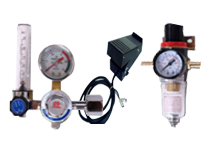
Auto-Darkening helmets enhance protection and production
Auto-Darkening Helmets are a boon to welders as they provide greater protection and comfort to enhance welding performance. These helmets automatically darken when a welder strikes the arc producing spark lights. They free the hands the additional task of having to lift and lower the faceplate, or removing the helmet altogether.
Auto-Darkening Welding Helmets incorporating latest lens technology are designed to offer the wearer enhanced arc-sensing capabilities, wider viewing facility, adjustable shade, delay controls and added to these features - they also weigh less. It is reported that auto darkening welding helmets can prevent many possible injuries because they cover a welder's eyes at all times without risking exposure to irritating fumes and flying debris.
Auto darkening welding helmets are typically useful to welders working indoors and under poor light conditions. Traditional welding helmets had the potential risk to blind a welder if he had to suddenly cease welding and kill the arc, leaving himself in total darkness.
Because of this specific advantage, many construction companies provide their welders auto darkening welding helmets so they can walk the buildings they are working in, without vision impairment. Auto-darkening helmets also help farmers working in open field because they react to sunlight much like the light an arc. It is expected that in the foreseeable future, all welding helmets will be auto darkening because their special features allow for customized-eye protection-something Federal authorities and Insurance agencies may soon make wearing mandatory.
There are two types of auto darkening helmets that welders use. One is battery-powered; the other is solar powered. Solar power is more convenient and efficient when working outdoors and battery-powered helmets are suitable when working inside large structures, underground areas and places where power supply is not available.
Both models however are fitted with sensors to react when the light brightens, and to indicate when it is time to adjust the special glass in the face shield to block just the right amount of light. The sensitivity control determines how sensitive the lens is to light, or how much light it takes for the auto-darkening lens to activate. For low-amperage welding, one can compensate by adjusting to higher sensitivity settings. Conversely, in high-amperage applications, lower sensitivity will darken the lens for the welding arc.
Delay control is there to show how long the lens stays dark after the arc is extinguished. The control, adjustable from .ten to one second, is available to help protect the eyes against the glowing hot weld pool quenches. For high-amperage applications, simply increase the delay for greater post-weld protection.
With the ever increasing popularity of auto-darkening helmets, it is necessary for welders to understand the latest advancements in lens technology and select the helmet that best meets his requirements. Anyone welder spending eight hours a day at his workplace will quickly come to appreciate the flexibility that today's advanced lens technology offers.
For private self-employed welders and welders who do very little welding work it may make no difference if the helmet has an auto-darkening sensor or not. Corporations and bigger industries however, will do well to invest in high-end auto darkening welding helmets to have a sensor for secondary arc light.






